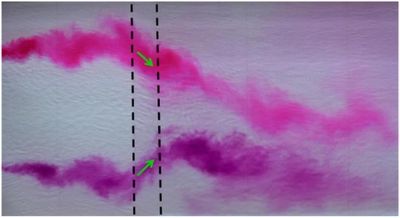Y.B. Broekema1*, R.J. Labeur1, W.S.J. Uijttewaal1
1 Delft University of Technology, This email address is being protected from spambots. You need JavaScript enabled to view it.
Located in the South-Western delta of the Netherlands, the Eastern Scheldt storm surge barrier is one of the most well-known flood defense structures of the Netherlands. It is 9 km long and has a semi‐open structure, consisting partly of dams (+/- 6 km) and partly of gates (+/- 3 km) to maintain a tidal saline‐water habitat in the Eastern Scheldt estuary. At both sides of the barrier, a bed protection is applied with a length of 500-600 m in streamwise direction, and downstream of this bed protection large-scale local erosion (scour) has developed. These so-called scour holes may become a potential threat to the stability of the barrier. A fundamental understanding of the local flow phenomenology is lacking, making future development and mitigation measures hard to determine.
Observations of Broekema et al. (2018) have shown that the flow adjacent to the barrier and the scour holes have characteristics of a tidal jet, that is, large velocity differences over the width of the inlet were present. It is exactly this combination of non-uniformity in the horizontal plane in combination with the increasing flow depth plane that gives rise to a highly complex flow field which, at times, may cause a self-amplification of the scouring process. To understand these flow patterns, a series of flow experiments were performed in the hydraulic laboratory of the Delft University of Technology. Archetypal horizontally non-uniform flow fields, like mixing layers, jets and wakes were investigated, and key observations of these flows will be discussed. Key characteristics from these flows include:
- The slope induces a redistribution of the flow in the horizontal plane. In many cases, a strong convergence of flow towards the high-velocity side(s) of the domain was observed (Figure 1).
- In some cases, this convergence leads to a suppression of vertical flow separation through a reduction in adverse pressure gradient.
It will be demonstrated that slope-induced changes of the flow can have large consequences for hydraulic loading, like for instance bed shear stress and drag. Results of these studies are not only applicable to the Eastern Scheldt storm surge barrier, but transcend to many other applications where similar flow fields are expected to occur.

Figure 1 Convergence of flow over a sloping section in the horizontal plane. The black-dotted lines denote the position of the slope. The water flows from left to right, and the high flow-velocities are concentrated in the centre of the domain. On the interface between the high and low velocities, mixing layers are developing, visualized by the purple ink. Because of the shallowness of this experiment, large-scale (quasi-)2D coherent structures may be recognized in the mixing layers. Taken from Van de Zande (2018).
References
Broekema, Y.B., Labeur, R.J., Uijttewaal, W.S.J. Analysis and Observations of the horizontal structure of a tidal jet at deep scour holes. JGR:Earth Surface, 123(12): 3162-3189, 2018.
Van de Zande, B. Jet behaviour in longitudinal deepening shallow flows. MSc thesis, TU Delft. 2018.










